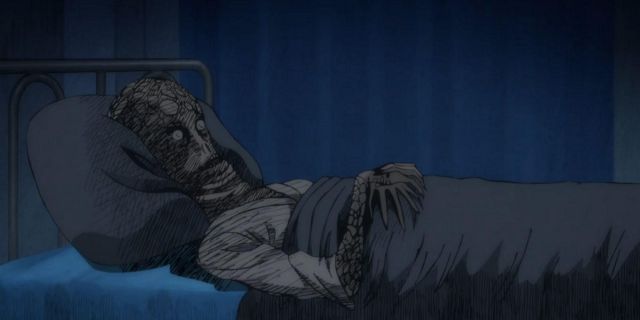Defined as a feeling of dread or panic that arises when a person confronts the limitations of their existence, existential fear is a concept that has been explored many times in the horror anime genre. The first examples that come to mind for many anime fans are series like Parasyte: The Maxim or the classic film, Perfect Blue, but Junji Ito’s work is rarely included in the conversation.
This is partly because Ito’s most popular stories are commonly centered around predator-to-prey dynamics, the loss of humanity, and obsessions. Ito’s Long Dream is one of the few that capture both body and cosmic horror, giving readers a haunting experience and leaving them to question the blurred lines between their own dreams and reality.
Two Patients Admitted: One Afraid To Die And One Afraid To Live

The story begins when Tetsuro Mukoda, a man complaining of increasingly long dreams, visits a hospital to be examined and treated by the celebrated neurosurgeon, Dr. Kuroda. Initially skeptical of Mukoda’s claims, Dr. Kuroda chalks up his bizarre experiences to hallucinations, but with some convincing from his assistant, Dr. Yamauchi, he agrees to admit Mukoda and study his symptoms in detail.
Meanwhile, another patient at the hospital, Mami Takeshima, who was being treated for a benign tumor, begins experiencing thanatophobia — a heightened fear of death — after having a frightening encounter with Mukoda, who wandered the halls at night in an attempt to avoid sleep.
The Simultaneous Aging Of Mukoda’s Mind, Body, And Soul

Upon examination, Dr. Kuroda discovers that Mukoda’s brief moments of REM sleep are when he reaches the depths of his condition. As time passes, the perceived length of Mukoda’s unpleasant dreams increases from months to years, to decades, and then to centuries. He begins to suffer from amnesia upon waking up, causing Dr. Kuroda to often remind him of his illness. Eventually, his dreams become several millennia long within his mind resulting in changes in his mannerisms, intonation, and physical appearance, as if he were really living the length of time he perceives his dreams and experiencing rapid evolution while still alive.
As the psychological effects of his condition take hold and his mental health further deteriorates, Mukoda struggles to differentiate his dreams from reality. This leads to an incident where he barges into Mami’s hospital room and accosts her, believing her to be his wife within the dream world. Dr. Kuroda manages to intervene and bring Mukoda back to his senses, to which then he fearfully asks the doctor, “What happens to the man who awakens from an eternal dream?”
Kuroda continues his study of Mukoda for several nights after, taking note of Mukoda’s worsening condition and mutations that are causing him to evolve into something barely human. Finally, Mukoda enters REM sleep for the last time and experiences an eternal dream. After nodding off due to being overworked and fatigued, Dr. Kuroda awakens to see Mukoda’s spirit fleeing his body as his flesh and bones crumble into dust, leaving behind a strange red crystal-like substance.
Dr. Kuroda’s Unconventional Cure For An Existential Crisis

Not long after, Mami informs Dr. Yamauchi that her thanatophobia is lessening, but she too is now starting to have longer dreams. Assuming the late Mukoda’s illness was somehow contagious, Dr. Yamauchi consults with Dr. Kuroda, who explains that he had secretly administered the red crystals to Mami, having realized they were the source of Mukoda’s condition. Disgusted and horrified, Dr. Yamauchi condemns Dr. Kuroda’s actions, to which Dr. Kuroda reasons that humanity’s fear of death can be eliminated with the option of having eternal dreams.
Originally written as a short manga story in The Junji Ito Horror Comic Collection, Long Dream was adapted into a live-action television film by Ukrainian film director, Higuchinsky in 2000. The story was later adapted as the final segment in the second episode of the anime horror anthology series, Junji Ito Collection. Whether fans were introduced to the story as a reader or a viewer, the unsettling feeling of uncertainty when one reaches the conclusion remains the same.
The Blurred Lines Between Dreams And Reality

Anxiety surrounding the unknown aspects of existence is common for people to experience at some point in their lives. Existential fear can come in many forms, and often stems from questioning the meaning of life and death or the presence of free will. Notably, this sense of dread can also derive from a lack of understanding of one’s own reality. Arguably, those feelings of insecurity regarding one’s reality, shared by the characters in Long Dream and people in the real world, are precisely what makes Ito’s story so unnerving.
For many people, dreams and nightmares can often feel like real-life events, leading some to theorize about the possible connections between one’s subconscious mind and one’s corporeal existence. The potential tie between the mind, body, and soul is a concept that is far from new in philosophy. Somehow, Ito perfectly captures this idea and elevates it to bring about a whole new level of uneasiness. The portrayal of horror pertaining to the unknowable and incomprehensible is executed flawlessly in Long Dream, leaving the audience shaken, yet relieved that it is merely a work of fiction.















Leave a Reply